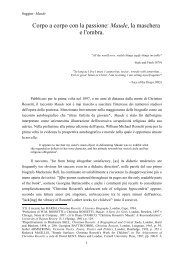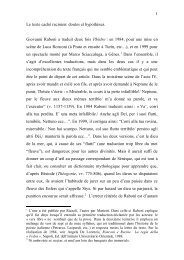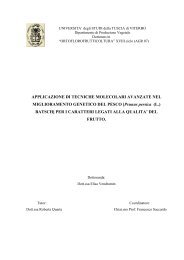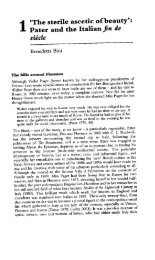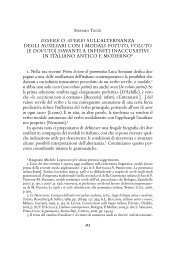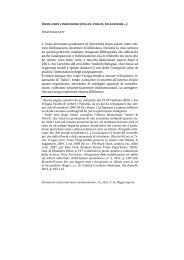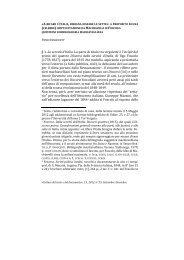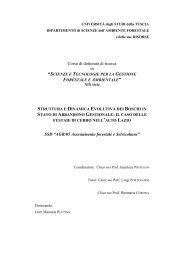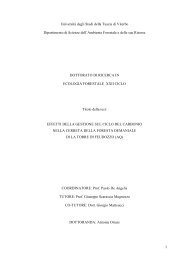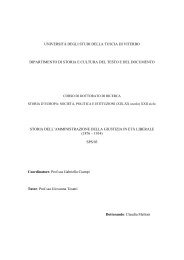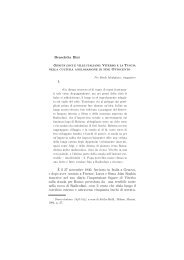drivers of soil respiration of root and microbial ... - Unitus DSpace
drivers of soil respiration of root and microbial ... - Unitus DSpace
drivers of soil respiration of root and microbial ... - Unitus DSpace
Create successful ePaper yourself
Turn your PDF publications into a flip-book with our unique Google optimized e-Paper software.
1.3. Soil <strong>respiration</strong> sources<br />
Soil <strong>respiration</strong> (Rs) is an important component <strong>of</strong> the ecosystem C budgets. After the<br />
photosynthesis, CO2 efflux from <strong>soil</strong> remains the second largest C flux in most ecosystems <strong>and</strong> can<br />
account for 60-90% <strong>of</strong> total ecosystem <strong>respiration</strong> (Goulden et al., 1996; Longdoz et al., 2000). On<br />
the global basis, the estimate <strong>of</strong> the contribution <strong>of</strong> Rs to the atmospheric CO2 emission is about<br />
75-80 GtC per year. Raich et al. (2002) estimated the mean global CO2 efflux from <strong>soil</strong> in the<br />
period between 1980 <strong>and</strong> 1994 to be 80.4 GtC.<br />
Due to the large quantity <strong>of</strong> C stored in the <strong>soil</strong> it has been hypothesized that relatively<br />
small changes in Rs induced by climate change or l<strong>and</strong> use change could rival the annual fossil<br />
fuel loading <strong>of</strong> atmospheric CO2 (Jenkinson et al., 1991; Raich <strong>and</strong> Schlesinger 1992). The<br />
realization that the <strong>soil</strong> could be a possible source <strong>of</strong> atmospheric CO2, together with the<br />
continuous increase in atmospheric CO2 concentration has given a rise to numerous methods to<br />
quantify this input.<br />
Soil <strong>respiration</strong> is the result <strong>of</strong> the production <strong>of</strong> CO2 in <strong>soil</strong>s from a combination <strong>of</strong> several<br />
belowground processes (Ryan <strong>and</strong> Law 2005; Trumbore, 2006). The most important are the<br />
biological activity <strong>of</strong> <strong>root</strong>s <strong>and</strong> associated microorganisms <strong>and</strong> the activity <strong>of</strong> heterotrophic bacteria<br />
<strong>and</strong> fungi living on litter <strong>and</strong> in the <strong>root</strong>-free <strong>soil</strong> (Fig. 4). Non biological processes related to<br />
chemical weathering in <strong>soil</strong>s are estimated to be a net carbon sink <strong>of</strong> ca. 0.3 Gt yr-1 (Jacobson et al.<br />
2000), thus being <strong>of</strong> less significance.<br />
Kuzyakov (2006) suggested five main contributors to total CO2 efflux (Fig. 4) :<br />
(1) <strong>microbial</strong> decomposition <strong>of</strong> SOM in the <strong>root</strong> free <strong>soil</strong>;<br />
(2) <strong>microbial</strong> decomposition <strong>of</strong> SOM in <strong>root</strong> affected <strong>soil</strong>, associated with a priming effect;<br />
(3) <strong>microbial</strong> decomposition <strong>of</strong> the dead plant residuals;<br />
(4) <strong>microbial</strong> decomposition <strong>of</strong> the rhizodeposits in the rhizosphere;<br />
(5) <strong>root</strong> <strong>respiration</strong>.<br />
The dynamic <strong>of</strong> different components <strong>of</strong> <strong>soil</strong> <strong>respiration</strong> is controlled by different biotic <strong>and</strong><br />
abiotic factors, such as temperature, water availability, photosynthetic activity, or plant<br />
phenological development. Heterotrophic processes control <strong>soil</strong> C storage <strong>and</strong> nutrient dynamics,<br />
while autotrophic component reflect plant activity <strong>and</strong> supply <strong>of</strong> organic compounds to <strong>root</strong>s from<br />
canopy (Hogberg et al., 2001; Singh et al., 2003; Binkley et al., 2006). In addition the response <strong>of</strong><br />
<strong>microbial</strong> <strong>and</strong> <strong>root</strong> components <strong>of</strong> <strong>soil</strong> <strong>respiration</strong> to changes in <strong>soil</strong> temperatures is different,<br />
exhibiting various Q10 values (Zhou et al., 2007). Thus, the potential change in <strong>soil</strong> CO2 efflux<br />
associated with global warming will largely depend on the relative contribution <strong>of</strong> <strong>root</strong> <strong>and</strong><br />
<strong>microbial</strong>-derived <strong>respiration</strong> tot total CO2 efflux. Therefore quantifying the components <strong>of</strong> <strong>soil</strong><br />
<strong>respiration</strong> is imperative for underst<strong>and</strong>ing the nature <strong>and</strong> extent <strong>of</strong> feedbacks between climate<br />
17




